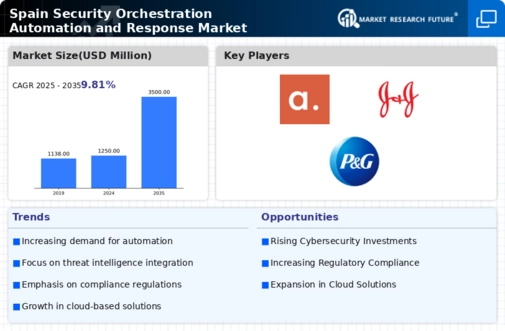Market Growth Projections
The Global Spain Security Orchestration Automation and Response Market Industry is projected to experience substantial growth over the coming years. With an estimated market value of 1250 USD Million in 2024, it is expected to reach 3500 USD Million by 2035. This growth trajectory suggests a compound annual growth rate (CAGR) of 9.81% from 2025 to 2035. The increasing adoption of security orchestration and automation solutions by organizations across various sectors is likely to drive this expansion. As businesses continue to prioritize cybersecurity, the market is poised for significant advancements, reflecting the evolving landscape of digital security.
Increasing Cybersecurity Threats
The Global Spain Security Orchestration Automation and Response Market Industry is experiencing growth due to the rising frequency and sophistication of cyber threats. As organizations face an increasing number of cyberattacks, the demand for effective security solutions becomes paramount. In 2024, the market is projected to reach 1250 USD Million, reflecting a heightened awareness of cybersecurity risks. Companies are investing in orchestration and automation tools to enhance their incident response capabilities, thereby mitigating potential damages. This trend indicates that organizations are prioritizing proactive measures to safeguard their digital assets, which is expected to drive market expansion.
Regulatory Compliance Requirements
The Global Spain Security Orchestration Automation and Response Market Industry is significantly influenced by stringent regulatory compliance requirements. Organizations are compelled to adhere to various data protection regulations, which necessitate the implementation of robust security measures. This compliance landscape drives the adoption of security orchestration and automation solutions, as they facilitate efficient monitoring and reporting processes. As regulations evolve, companies are likely to invest in these technologies to ensure compliance and avoid penalties. The market's growth trajectory suggests that organizations recognize the importance of aligning their security strategies with regulatory frameworks, thereby fostering a culture of accountability and transparency.
Integration of Advanced Technologies
The Global Spain Security Orchestration Automation and Response Market Industry is benefiting from the integration of advanced technologies such as artificial intelligence and machine learning. These technologies enhance the capabilities of security orchestration tools, enabling organizations to automate threat detection and response processes. As a result, businesses can respond to incidents more swiftly and effectively. The anticipated growth from 1250 USD Million in 2024 to 3500 USD Million by 2035, with a CAGR of 9.81% from 2025 to 2035, underscores the potential of these technologies in transforming security operations. This trend indicates that organizations are increasingly leveraging innovative solutions to stay ahead of evolving threats.
Rising Demand for Cloud Security Solutions
The Global Spain Security Orchestration Automation and Response Market Industry is witnessing a surge in demand for cloud security solutions. As organizations migrate to cloud environments, the need for effective security measures becomes critical. Security orchestration and automation tools provide the necessary framework to manage and secure cloud-based assets efficiently. This shift towards cloud adoption is likely to drive market growth, as organizations seek to protect their data and applications in increasingly complex environments. The emphasis on cloud security reflects a broader trend where businesses prioritize agility and scalability while ensuring robust security measures are in place.
Growing Awareness of Cybersecurity Best Practices
The Global Spain Security Orchestration Automation and Response Market Industry is experiencing growth driven by an increasing awareness of cybersecurity best practices among organizations. As businesses recognize the importance of implementing comprehensive security strategies, the demand for orchestration and automation solutions rises. Organizations are investing in training and resources to educate employees about cybersecurity risks and best practices. This cultural shift towards prioritizing security is likely to enhance the adoption of security technologies, thereby contributing to market growth. The focus on fostering a security-conscious environment indicates that organizations are taking proactive steps to mitigate risks and protect their digital assets.














Leave a Comment